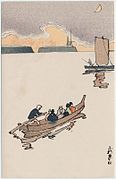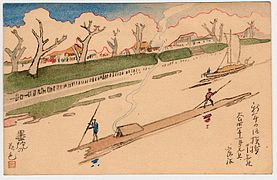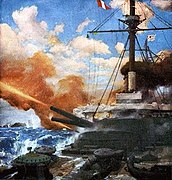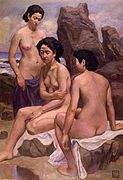Nakamura Fusetsu
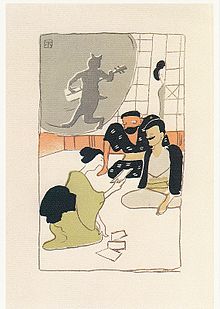
Nakamura Fusetsu ( Japanese 中 村 不 折 ; actual first name Sakutarō ( 鈼 太郎 ); born August 19, 1866 in Edo ; died June 6, 1943 ) was a Japanese painter in the "western" Yōga style of Meiji , Taishō and early Shōwa period . He is also known as a calligrapher .
life and work
When Nakamura was young, his father moved the family to Nagano Prefecture . Since he was talented in painting, he received his first lessons in nanga and painting in the European style. In 1887 he went to Tōkyō and enrolled with Koyama Shōtarō (1857-1916) in his school Jūichikai kenkyūjo ( 十一 会 研究所 ).
In 1900 Nakamura submitted pictures for the world exhibition in Paris and was awarded a prize. The following year he went to France and studied under Collin , with whom his teacher Koyama had already studied, then switched to the older Laurens . In 1905 Nakamura returned to Japan and there joined the “Pacific Society for Western Painting” ( 太平洋 画 会 , Taiheiyō gakai ).
In 1907 Nakamura became a member of the jury for the first industrial exhibition in Tōkyō ( 東京 府 勧 業 博 覧 会 , Tōkyō-fu Kangyō hakurankai ) and also a member of the jury for the art exhibition of the Ministry of Culture, which was held for the first time in the same year ( 文部省 美術展 覧 会 , Mombushō bijutsu tenrankai ). In 1919 he became a member of the Imperial Academy of Arts ( 帝国 美術 院 , Teikoku bijutsu-in ) and in 1934 director of the Pacific School.
Nakamura's illustrations for Natsume Sōseki's “Ich der Kater” from 1906 and the series “Six beautiful round views of Tōkyō” ( 曲線 美 東 都 六 景 , Kyokusembi Tōto rokkei ) from 1915 show a light, fluid style.
Nakamura then turned to history painting, creating images that seem heavier. Exemplary images are “Waking up in the orchid pavilion ” ( 賺 蘭亭 図 , Rantei o mezamu ku no zu ) and “Lu Sheng's dream” ( Handan ) ( 盧 生 の 夢 (邯鄲) , Rosei no yume (Kantan) ), scenes from the Biyan Lu . Nakamura is represented in the Meiji Memorial Gallery with a naval battle picture from the Japanese-Russian War .
Nakamura was also known as a calligrapher. In 1936 a museum for his calligraphy ( 書 道 博物館 ) was opened in the district of Negishi in Tōkyō .
photos
Remarks
literature
- Suzuki, Toshihiko (Ed.): Nakamura Fusetsu . In: Nihon daihyakka zensho (Denshibukku-han), Shogakukan, 1996.
- Laurance P. Roberts: Nakamura Fusetsu . In: A Dictionary of Japanese Artists. Weatherhill, 1976. ISBN 0-8348-0113-2 .
Web links
| personal data | |
|---|---|
| SURNAME | Nakamura, Fusetsu |
| ALTERNATIVE NAMES | 中 村 不 折 (Japanese); Nakamura, Sakutarō (real name); 鈼 太郎 (real name, Japanese) |
| BRIEF DESCRIPTION | Japanese painter |
| DATE OF BIRTH | August 19, 1866 |
| PLACE OF BIRTH | Edo |
| DATE OF DEATH | June 6, 1943 |

